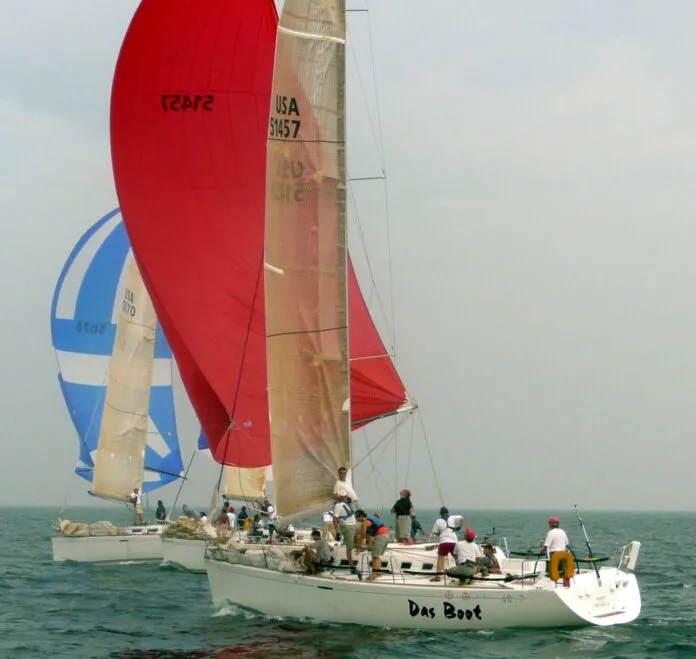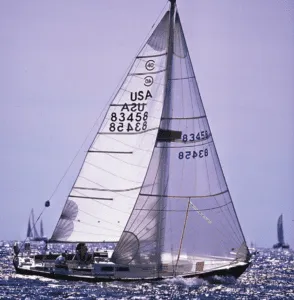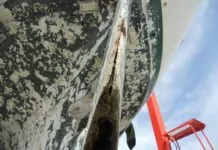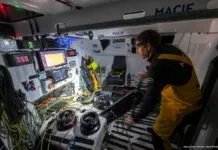
Over the past few decades, we have seen a tremendous advancement in sail design technologies—innovative sail materials are now common in the marketplace and computer programs are used to design and model sails. This innovation process is a continuation of what has been happening over thousands of years. Sails have developed from those used on square-rigged vessels from as early as 3000 BC in Egypt and the Mediterranean. This sail design spread rapidly and evidence of square-rigged ships exists in Europe, Arabia, China and as far as the Philippines. However, it was not until the 1600s when mariners first fashioned headsails as we know them today. Mounting sails forward of the mast allows ships to point closer into the wind, which saves ships the hassle of waiting for favorable wind to complete trade or navigation. Evidence of these innovative sails can be found both in Polynesian sea-faring canoes in Hawaii as well as in Europe. The innovation quickly spread during the age of discovery and in the 300-plus years that have followed, sail making and ship design have created numerous headsails for a sailor to choose from. Jibs, genoas, staysails, code zeros, symmetric spinnakers and asymmetric spinnakers can be deployed to help you sail in myriad conditions. This article will discuss the nuances of modern headsails and spinnakers and the best use case for each sail.
The main function of a headsail in today’s sloop-rigged boats, which is a boat with a single mast, a single headsail and a single mainsail, is balance. This is easiest explained by thinking about monohull keelboats. The keel and mast are stacked above each other as they form the center point of the boat from which the vessel pivots. Imagine a vessel on a broad reach with the wind perpendicular to the beam, when flying both the jib and main sail the boat should track in a relatively straight line. Now furl the headsail and suddenly the skipper will experience weather helm as the force of the wind acts on the main, pushing her stern down and bow up into the wind. The opposite can be said if the boat were to fly only a headsail—the skipper experiences lee helm as the bow of the boat is pushed away from the wind causing the skipper to counter steer to keep the boat on course. There is a lot that can be done to de-power sails, from twisting them off to spill wind, flattening them to decrease lift or reducing sail area. Boats are designed and optimized with a specific headsail in mind for a specific task, popular cruising boats of the Beneteau, Jeanneau and Bavaria variety have genoas, while race boats favor jibs, older Transpac boats favored symmetric spinnakers and maxi yachts favor asymmetric spinnakers for reasons we’ll discuss.
JIBS

Jibs are sails that are confined to the fore triangle of a boat formed by the mast, forestay and deck. They help boats point close to the wind as they can be trimmed closer to the center line than any other headsail. They are also cut to stop ahead of the mast and spreaders. This is the headsail you will see on modern sport boats, think anything beginning with J. Jibs offer exceptional upwind performance, especially for getting around a racecourse, but suffer as the wind moves aft. These sails can easily be in shadow of a mainsail, leading to the need for a different cut jib. When I race, we carry several jibs on the boat depending on the fleet’s rules, weather conditions and race distance. These jibs have varying sail areas and are made of varying thicknesses of fabric. Typically, I will have a jib 1 that is good to 8-10 knots sustained wind speed, then a jib 2 rated to 15-17 knots, and finally a reduced-area thick jib 3. As conditions evolve over a day of racing, the crew changes these headsails to match the current conditions.
GENOAS

As headsails extend past the mast, they are called genoa. If you have expertise with genoa, you have probably heard them referred to as 110, 120 or 150. These numbers refer to the size of the sail as it relates to the fore triangle. If a jib is a sail that occupies 100 percent of the fore triangle, a sail that is 1.5 times as large as that fore triangle is a 150 genoa. These deep-cut sails are fantastically versatile and are commonly paired with a roller fuller, a setup ubiquitous with cruising, although they are also found on racing vessels alike. The roller fuller makes it easy for a skipper to adjust the sail they have out. Unlike the jib example, when race boats carry three sails and need as many people to douse, flake and re-hoist a new sail, many cruising boats are outfitted with genoas that can easily be furled and deployed as needed when paired with a furling foil. To leave a calm anchorage for a cruise, for example, it’s a calm 6 knots and you deploy your full 150 genoa. As the day progresses and the wind picks up, if you start experiencing lee helm you can reduce that 150 genoa by furling it until the helm returns to a balanced centered tracking position. As the day continues, if the wind falls off simply unfurl the sail and you’re off. I was fortunate enough to spend some time sailing on a friend’s Saber 35 mark II in Chicago with an enormous 180 genoa it was the optimal cruising machine, allowing for easy boat and sail handling while grilling sausages and drinking in the Chicago skyline. These larger genoas offer much more utility than even the 150.

Another advantage of the genoa is since it extends aft farther than a jib, the extra sail area lends itself to off-breeze sailing. If you are on a close-hauled point of sail, 45-55 degrees off the wind, there is not much need for extra sail area as a main creates a sizable wind shadow. But as you fall off the wind and open the slot between the mast and leech of the jib, a deeper sail allows you to capture more wind. The extra sail area also pays dividends when you get into the dead downwind or running point of sail. You can also easily jibe a headsail to windward and, using a simple spar called a whisker pole, you can fly the genoa like a spinnaker without the fuss of hoisting a spinnaker, yet it still provides similar performance. This is a great option for sailing short-handed or with inexperienced crew as the amount of people power needed to deploy a genoa in this way is less than some other headsails.
SPINNAKERS
Spinnakers are not classified as headsails but they are important to think about for ahead-of-the-mast sail choices. Jibs are to upwind as spinnakers are to downwind. These sails can be broken into two categories: symmetric and asymmetric. The classification refers to the shape of the sail. You can lay a symmetric spinnaker out in a sail loft, or if you don’t have a loft, find a soft area of grass. A symmetric sail will be evenly shaped or symmetric about a center line from the head of the sail to the middle of the foot. An asymmetric spinnaker will be similarly shaped but not symmetric about the same line. With asymmetric spinnakers, the luff is longer than the leech.

Why do we have these two sails? Symmetric sails excel at doing dead downwind, think 175 true wind angle. This is thanks to the rigging for these sails. The setup includes a spar called a spinnaker pole, port and starboard sheets, and a port and starboard guy. The spinnaker pole holds the tack out-board and the pole terminates on the mast of the vessel. The pole has the ability to be raised and lowered, giving the crew an infinite amount of places to set the tack of the spinnaker depending on wind angle and pressure. A sheet is just like a sheet on a jib—it controls how far in out the sail can be. The guy controls how far fore and aft the pole can be located. In reaching conditions, the spinnaker pole can be as far forward as the forestay and as far back as perpendicular to the mast or abeam for dead downwind sailing. Since the tack can be trimmed, the sails are extremely versatile but require more crew to trim, jibe and set. The upside to the extra rigging and effort is the reward of being able to efficiently catch the wind on a variety of downwind angles.
The next downwind-oriented sail is an asymmetric spinnaker. The move away from the Santa Cruz downwind symmetric sled design to the modern asymmetric design has several considerations. From a performance aspect, asymmetric spinnakers can be deployed and are optimized for reaching conditions. In general, asymmetric spinnakers generate more power at a broad reach than dead downwind. Compared to a boat with a symmetric spinnaker, boats with only an asymmetric spinnaker will not be able to point as low—a symmetric spinnaker boat can go virtually 180 degrees away from the wind. Quantum sail makers illustrates this on their website well, as wind pressure increases from 8 kts to 13 kts to 19 kts, a boat’s apparent wind angle could be 145, 155, and 165 respectively. Asymmetric sails sail hotter angles faster than their symmetric counterparts.
Asymmetric sails are prevalent on all keelboats, from those competing in the Vendee Globe to most odyssey yachts in the Caribbean. The reason for this prevalence is they require fewer crew to handle and are easy to trim with only a single sheet, since the tack is fixed there is no need to trim a pole using guys, downhaul and topping lifts.

Code zero: For racing, code zero sails are often categorized as spinnakers. These are powerful, full-reaching sails optimized for the narrow bands in the apparent wind. Unlike jibs and genoas, these are categorized as flying sails that aren’t attached to standing rigging or a forestay, like jibs and genoas.
Since these sails are designed to be optimized at a narrow reaching angle, the sails are cut to fill the slot between the mast and forestay and capture all the wind. As you time and ease a sail, you open or close the slot. Boats with plenty of real estate up at the pointy end like a TP52 or modern maxi fill that void with stay sails. These are a series of smaller sails typically on roller fullers that fill the void for large race boats. Think about any of the images on a Sharon Green calendar of maxi yacht power reaching around the Windward Islands with various sails stacked ahead of the mast and you can see how the sailors are capturing as much wind as they can.

CONCLUSION
This information is at a beginner level on purpose, to remind you how to explain these concepts to new sailors. For more detailed info on sail types, check out Practical Sailor‘s video with sailmaker Joe Cooper. For those who are interested in how software can assist your sail choices in terms of route-planning, check out Expedition. Their software allows you to enter all the headsails and spinnakers you have, from a few genoas and an asymmetric up to a shipping-container load of sails if you’re on a serious race program. Navigators or captains can use software paired with weather files to give a crew the optimal time to use what sail based on how strong the wind is and its angle to the boat.

This discussion of headsails and spinnakers is about what we know works, but as foiling becomes common at the top level of sailing and the technology trickles down into more consumer-oriented boats like the ClubSwan 36, it will be interesting to see what innovations headsail and spinnaker design will bring in the coming decades.





































Excellent explanation!!!!